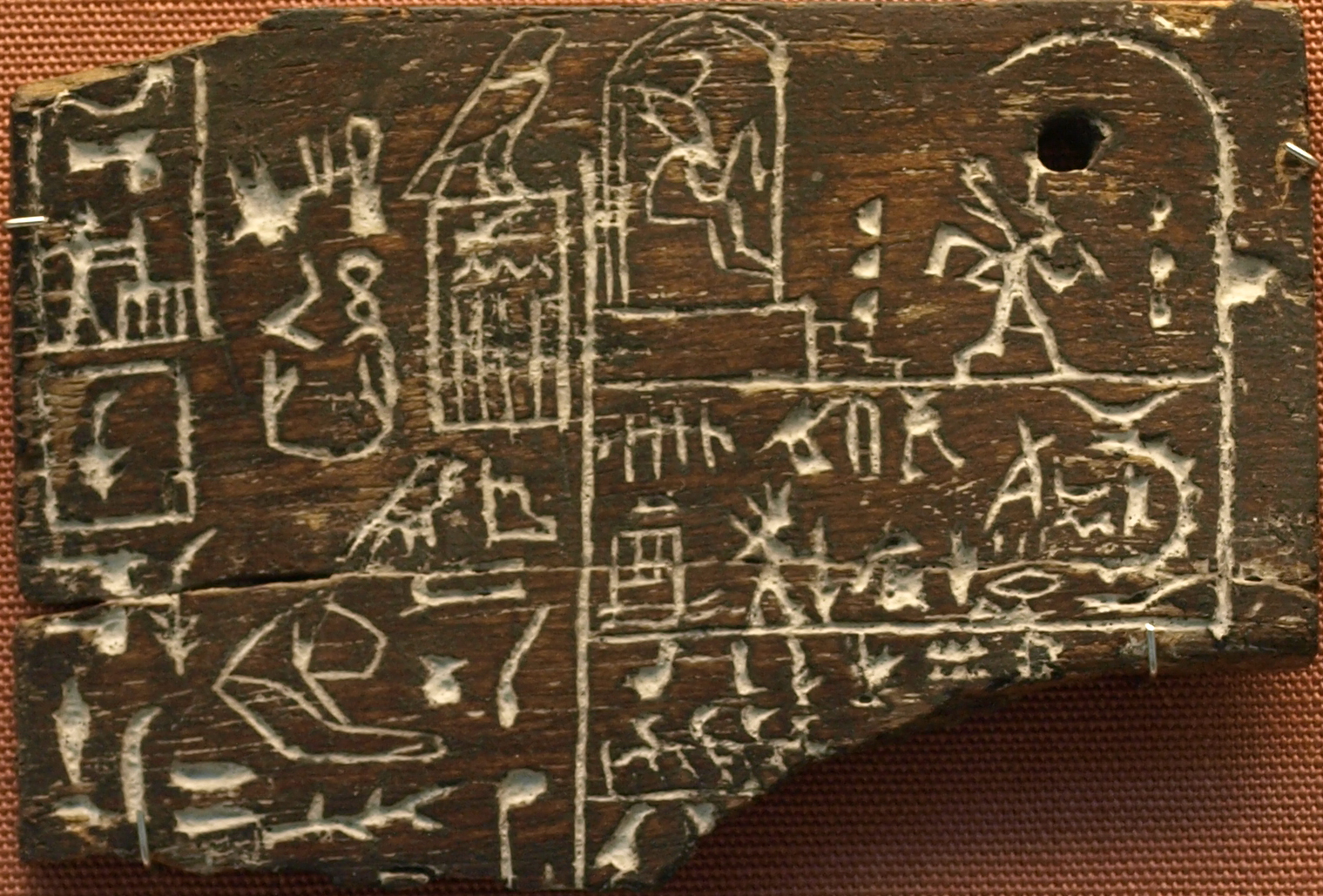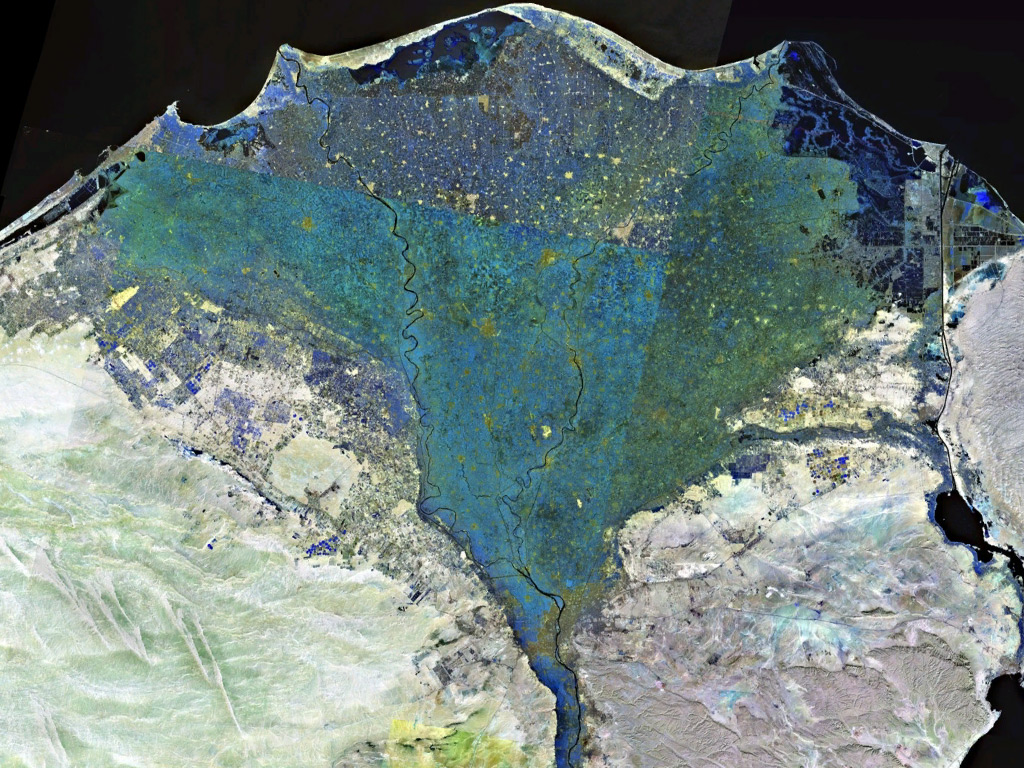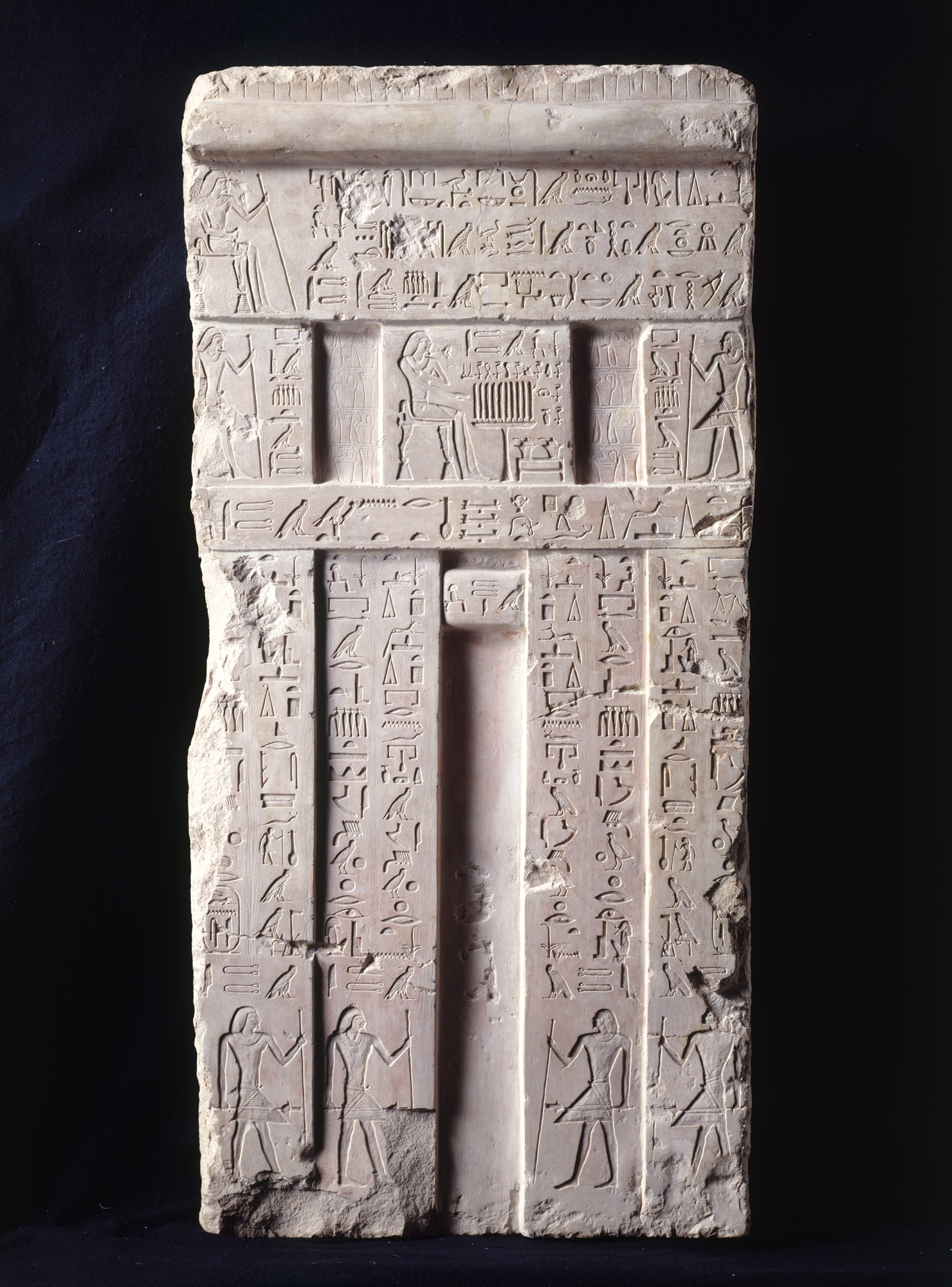|
Naos (hieroglyph)
Naos (Greek ναός "temple, shrine") is the descriptive name given to an Egyptian hieroglyph (Gardiner O18). It is incorporated in another hieroglyph: The Jubilee pavilion hieroglyph is a side view of the pharaoh seated, in opposing views, wearing the two separate crowns, the crown of the South, the hedjet, and the crown of the North (the Nile Delta), the deshret. The pavilion is composed of two side views of the naos hieroglyph. The early Old Kingdom labels, for example Pharaoh Den, portrayed him in a side view in his naos. An example of the combined, opposed, view with the two crowns, is the lintel of Senusret II, 12th Dynasty, 19th century BCE. It shows the naos' curved roofs of each half of the pavilion hieroglyph. A ''naophoros'' "temple-bearer" is a type of statue holding the naos symbol. An example is the Ramesside-era statue of Panehsy, overseer of the treasury. The earliest examples of such statues date to the 18th Dynasty.Jacques Vandier, ''Manuel d'archéologie ... [...More Info...] [...Related Items...] OR: [Wikipedia] [Google] [Baidu] |
Egyptian Hieroglyph
Ancient Egyptian hieroglyphs ( ) were the formal writing system used in Ancient Egypt for writing the Egyptian language. Hieroglyphs combined ideographic, logographic, syllabic and alphabetic elements, with more than 1,000 distinct characters.In total, there were about 1,000 graphemes in use during the Old Kingdom period; this number decreased to 750–850 during the Middle Kingdom, but rose instead to around 5,000 signs during the Ptolemaic period. Antonio Loprieno, ''Ancient Egyptian: A Linguistic Introduction'' (Cambridge: Cambridge UP, 1995), p. 12. Cursive hieroglyphs were used for religious literature on papyrus and wood. The later hieratic and demotic Egyptian scripts were derived from hieroglyphic writing, as was the Proto-Sinaitic script that later evolved into the Phoenician alphabet. Egyptian hieroglyphs are the ultimate ancestor of the Phoenician alphabet, the first widely adopted phonetic writing system. Moreover, owing in large part to the Greek and Aramaic ... [...More Info...] [...Related Items...] OR: [Wikipedia] [Google] [Baidu] |
Jubilee Pavilion (hieroglyph)
The ''Jubilee Festival'' for the Pharaoh, the Heb Sed is represented in hieroglyphs by a Jubilee Pavilion Hieroglyph. It is Gardiner Sign Listed as no. O23. However it often appears with other pavilion, or festival hieroglyphs: the ''Hall'', no. O22, O22 and an ''alabaster Basin'', no. W3. W3 An alternate hieroglyph, the Basin combined with the Hall, W4is represented by Gardiner no. W4. A ligatured combination of the Basin with the Pavilion, O23:W3 is shown in some iconographic scenes, (Ramses II, Temple of Amun at Karnak).Wilkinson, 1992, p. 144-(graphic), and p. 145-(analysis). The Pavilion hieroglyph The pavilion hieroglyph is a side view of the pharaoh seated, in opposing views, wearing the two separate crowns, the crown of the South, the white crown, and the crown of the North (the Delta), the red crown. The pavilion is composed of two side views of the naos (hieroglyph), Gardiner no. O18. O18 The early Old Kingdom labels, for example Pharaoh Den, portrayed him in a side ... [...More Info...] [...Related Items...] OR: [Wikipedia] [Google] [Baidu] |
Pharaoh
Pharaoh (, ; Egyptian language, Egyptian: ''wikt:pr ꜥꜣ, pr ꜥꜣ''; Meroitic language, Meroitic: 𐦲𐦤𐦧, ; Biblical Hebrew: ''Parʿō'') was the title of the monarch of ancient Egypt from the First Dynasty of Egypt, First Dynasty () until the Roman Egypt, annexation of Egypt by the Roman Republic in 30 BCE. However, the equivalent Egyptian language, Egyptian word for "king" was the term used most frequently by the ancient Egyptians for their monarchs, regardless of gender, through the middle of the Eighteenth Dynasty during the New Kingdom of Egypt, New Kingdom. The earliest confirmed instances of "pharaoh" used contemporaneously for a ruler were a letter to Akhenaten (reigned –1336 BCE) or an inscription possibly referring to Thutmose III (–1425 BCE). In the early dynasties, ancient Egyptian kings had as many as ancient Egyptian royal titulary, three titles: the Horus name, Horus, the prenomen (Ancient Egypt), Sedge and Bee (wikt:nswt-bjtj, ''nswt-bjtj''), and ... [...More Info...] [...Related Items...] OR: [Wikipedia] [Google] [Baidu] |
Hedjet
Hedjet () is the White Crown of pharaonic Upper Egypt. After the unification of Upper and Lower Egypt, it was combined with the Deshret, the Red Crown of Lower Egypt, to form the Pschent, the double crown of Egypt. The symbol sometimes used for the White Crown was the vulture goddess Nekhbet shown next to the head of the cobra goddess Wadjet, the uraeus on the Pschent. History The white crown, along with the red crown, has a long history with each of their respective representations going back into the Predynastic Period, indicating that kingship had been the base of Egyptian society for some time. The earliest image of the hedjet was thought to have been in the Qustul in Nubia. According to Jane Roy, "At the time of Williams’ argument, the Qustul cemetery and the ‘royal’ iconography found there was dated to the Naqada IIIA period, thus antedating royal cemeteries in Egypt of the Naqada IIIB phase. New evidence from Abydos, however, particularly the excavation of Cem ... [...More Info...] [...Related Items...] OR: [Wikipedia] [Google] [Baidu] |
Nile Delta
The Nile Delta (, or simply , ) is the River delta, delta formed in Lower Egypt where the Nile River spreads out and drains into the Mediterranean Sea. It is one of the world's larger deltas—from Alexandria in the west to Port Said in the east; it covers of the Mediterranean coastline and is a rich agricultural region. From north to south the delta is approximately in length. The Delta begins slightly down-river from Cairo. Geography From north to south, the delta is approximately in length. From west to east, it covers some of coastline. The delta is sometimes divided into sections, with the Nile dividing into two main distributary, distributaries, the Damietta and the Rosetta, flowing into the Mediterranean at port cities with the same names. In the past, the delta had several distributaries, but these have been lost due to flood management, flood control, silting and changing relief. One such defunct distributary is Wadi Tumilat. The Suez Canal is east of the delta ... [...More Info...] [...Related Items...] OR: [Wikipedia] [Google] [Baidu] |
Deshret
Deshret () was the Red Crown of Lower Egypt. It was red bowl shaped with a protruding curlicue. When combined with the Hedjet (White Crown) of Upper Egypt, it forms the Pschent (Double Crown), in ancient Egyptian called the ''sekhemti''. The Red Crown in Egyptian language hieroglyphs eventually was used as the vertical letter "n". The original "n" hieroglyph from the Predynastic Period and the Old Kingdom was the sign depicting ripples of water. The word Deshret also referred to the desert Red Land on either side of Kemet (Black Land), the fertile Nile river basin. Significance In mythology, the earth deity Geb, original ruler of Egypt, invested Horus with the rule over Lower Egypt. The Egyptian pharaohs, who saw themselves as successors of Horus, wore the ''deshret'' to symbolize their authority over Lower Egypt. Other deities wore the ''deshret'' too, or were identified with it, such as the protective serpent goddess Wadjet and the creator-goddess of Sais, Neith, who of ... [...More Info...] [...Related Items...] OR: [Wikipedia] [Google] [Baidu] |
Old Kingdom
In ancient Egyptian history, the Old Kingdom is the period spanning –2200 BC. It is also known as the "Age of the Pyramids" or the "Age of the Pyramid Builders", as it encompasses the reigns of the great pyramid-builders of the Fourth Dynasty, such as King Sneferu, under whom the art of pyramid-building was perfected, and the kings Khufu, Khafre and Menkaure, who commissioned the construction of the pyramids at Giza. Egypt attained its first sustained peak of civilization during the Old Kingdom, the first of three so-called "Kingdom" periods (followed by the Middle Kingdom and New Kingdom), which mark the high points of civilization in the lower Nile Valley. The concept of an "Old Kingdom" as one of three "golden ages" was coined in 1845 by the German Egyptologist Baron von Bunsen, and its definition evolved significantly throughout the 19th and the 20th centuries. Not only was the last king of the Early Dynastic Period related to the first two kings of the Old Ki ... [...More Info...] [...Related Items...] OR: [Wikipedia] [Google] [Baidu] |
Den (pharaoh)
Den, also known as Hor-Den, Dewen, and Udimu, was the Horus name of a pharaoh of the Early Dynastic Period who ruled during the First Dynasty of Egypt. He is the best archaeologically-attested ruler of this period, credited with bringing prosperity to his realm. Den was attributed the title "King of Upper and Lower Egypt" and wore the double crown (red and white). Notably, the floor of his tomb at Umm El Qa'ab, near Abydos, was constructed using red and black granite, making it the earliest known use of this hard stone as a building material in Egypt with a flight of stairs leading to it. During his long reign, he established many of the customs of court ritual and royalty drawn on by later rulers and was held in high regard by his immediate successors. Length of reign The Ancient Egyptian historian Manetho called him “Oúsaphaîdos” and credited him with a reign of 20 years, William Gillan Waddell: ''Manetho (The Loeb Classical Library, Volume 350)''. Harvard Univers ... [...More Info...] [...Related Items...] OR: [Wikipedia] [Google] [Baidu] |
Senusret II
Senusret II or Sesostris II was the fourth pharaoh of the Twelfth Dynasty of Egypt. His pyramid was constructed at El-Lahun. Senusret II took a great deal of interest in the Faiyum oasis region and began work on an extensive irrigation system from Bahr Yussef through to Lake Moeris through the construction of a dike at El-Lahun and the addition of a network of drainage canals. The purpose of his project was to increase the amount of cultivable land in that area. The importance of this project is emphasized by Senusret II's decision to move the royal necropolis from Dahshur to El-Lahun where he built his pyramid. This location would remain the political capital for the 12th and 13th Dynasties of Egypt. Senusret II was known by his prenomen Khakheperre, which means "The Ka of Re comes into being". The king also established the first known workers' quarter in the nearby town of Senusrethotep ( Kahun). Reign Co-regency Co-regencies are a major issue for Egyptologists' understandi ... [...More Info...] [...Related Items...] OR: [Wikipedia] [Google] [Baidu] |
Twelfth Dynasty Of Egypt
The Twelfth Dynasty of ancient Egypt (Dynasty XII) is a series of rulers reigning from 1991–1802 BC (190 years), at what is often considered to be the apex of the Middle Kingdom of Egypt, Middle Kingdom (Dynasties XI–XIV). The dynasty periodically expanded its territory from the Nile delta and valley South beyond the Cataracts of the Nile, second cataract and East into Canaan. The Twelfth Dynasty was marked by relative stability and development. It has a notably well recorded history for the period. Its first pharaoh was Amenemhat I and its final was Sobekneferu. History The chronology of the Twelfth Dynasty is the most stable of any period before the New Kingdom of Egypt, New Kingdom. The Turin King List, Turin Royal Canon gives 213 years (1991–1778 BC). Manetho stated that it was based in Thebes, Egypt, Thebes, but from contemporary records it is clear that the first king of this dynasty, Amenemhat I, moved its capital to a new city named "Amenemhat-itj-tawy" ("Amenemha ... [...More Info...] [...Related Items...] OR: [Wikipedia] [Google] [Baidu] |







